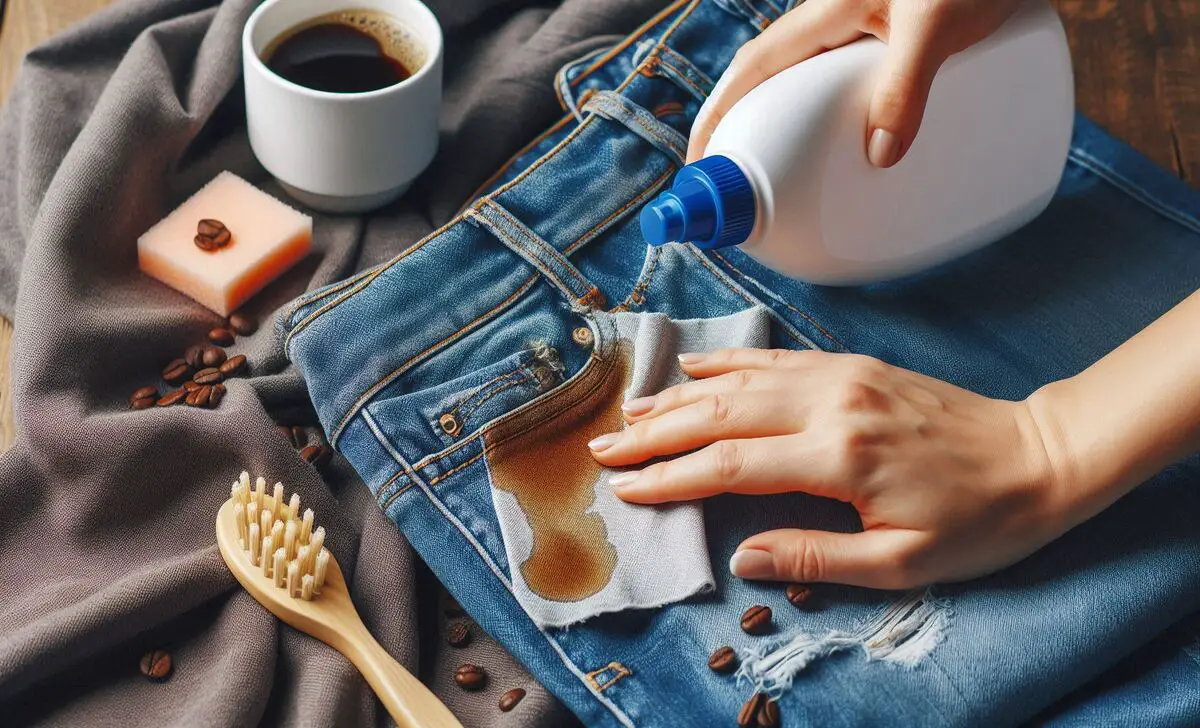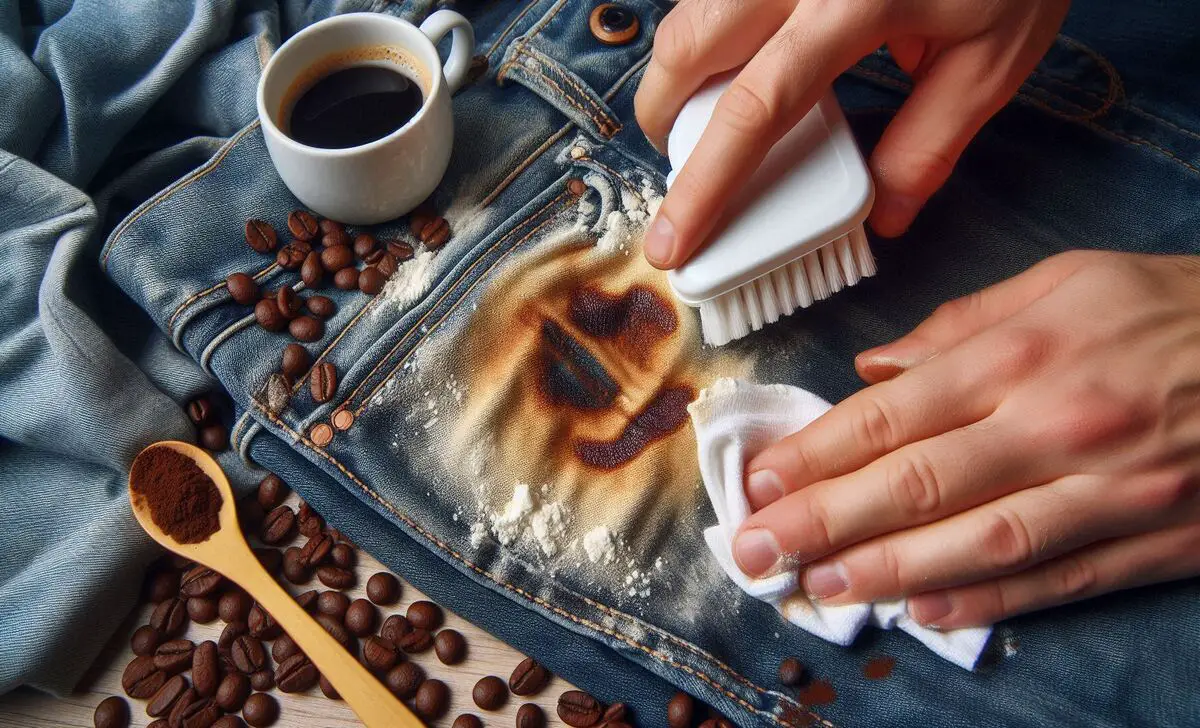Addressing coffee stains promptly on jeans is crucial to prevent them from setting and becoming permanent marks. Coffee stains can quickly penetrate the fabric and leave noticeable discolouration if not treated promptly and effectively.
Fortunately, there are several methods you can use to remove coffee stains from jeans successfully using common household items. These methods typically involve gentle yet effective cleaning agents that lift the stain without damaging the denim fabric.
By taking immediate action and choosing the right cleaning method based on the severity of the stain, you can restore your jeans to their original clean and pristine condition. Whether your jeans are light or dark wash, knowing how to treat coffee stains properly ensures they remain fresh and well-maintained for longer. Scroll down for more information:

Immediate Action
When a coffee spill happens on your jeans, taking immediate action is crucial to prevent the stain from setting and becoming difficult to remove. Household items like baking soda and laundry detergent can effectively tackle coffee stains before they become permanent marks. Here’s a step-by-step guide to help you get coffee out of jeans:
- Act Quickly: As soon as the spill occurs, blot the area gently with a clean cloth or paper towel to absorb as much coffee as possible.
- Avoid Rubbing: Do not rub the stain, as this can push the coffee deeper into the fabric fibres and make it harder to remove.
- Apply Baking Soda: Sprinkle baking soda directly onto the stain to help absorb any remaining liquid and neutralize odour.
- Pre-Treat with Detergent: Apply a small amount of liquid laundry detergent directly to the stain and gently rub it into the fabric with your fingers or a soft brush.
- Let it Sit: Allow the baking soda and detergent to sit on the stain for about 10-15 minutes to penetrate and loosen the coffee residue.
- Rinse and Wash: Rinse the treated area with cold water to remove the cleaning agents, then launder the jeans as usual following the care instructions on the label.
Preparing For Stain Removal

Removing coffee stains from jeans requires gathering essential materials such as a cloth, stain remover, or detergent. Start by blotting the stained area with a clean cloth to absorb excess coffee. Avoid rubbing, as this can push the stain deeper into the fabric. Next, rinse the stain with cold water to dilute it.
Apply a small amount of liquid detergent directly to the stain and gently work it into the fabric with your fingers or a soft brush for effective cleaning. Let the detergent sit for a few minutes to penetrate the fibres.
Then, launder the jeans in warm water with a white clothes load to prevent colour transfer. Check the stain before drying; if necessary, repeat the cleaning process until the coffee stain is fully removed. This method ensures readiness for effective stain removal without damaging the jeans.
Applying Stain Remover Or Detergent
When tackling a coffee stain on jeans, applying stain remover or detergent effectively can significantly remove the stain completely. Coffee stains are best treated promptly, especially when they are fresh and haven’t set into the fabric. Here’s how to apply stain remover or detergent to get coffee out of jeans:
Start by blotting the stain gently with a white cloth or paper towel to absorb excess coffee. Avoid rubbing, as this can spread the stain further into the fabric. Then, apply a small amount of liquid detergent or stain remover directly onto the stained area.
Use cool water to dampen the cloth and gently work the product into the fabric, focusing on the stained area. Allow the detergent or stain remover to sit on the stain for a few minutes to penetrate and lift the coffee residue. Finally, rinse the jeans under cool running water to remove the detergent and coffee stain, then launder as usual.
Tips for Applying Stain Remover or Detergent:
- Blotting: Gently blot the stain with a white cloth to absorb excess coffee.
- Applying Detergent: Apply liquid detergent or stain remover directly to the stained area.
- Working into Fabric: Use a white cloth dampened with cool water to work the product into the fabric.
- Rinsing: Rinse the jeans under cool running water to remove the detergent and coffee residue.
Washing In Cold Water

When dealing with coffee stains on jeans, washing them in cold water is a recommended method, especially for fresh stains, to prevent the coffee from setting and becoming more difficult to remove. Cold water helps to lift the stain without allowing it to penetrate deeper into the fabric. For fresh coffee stains on jeans, gently blot the stain with a clean cloth or paper towel to absorb excess liquid. Then, rinse the stained area under cold running water to flush out as much coffee as possible.
Steps for Washing Coffee-Stained Jeans in Cold Water:
- Blotting the Stain: Use a clean cloth or paper towel to blot the fresh coffee stain to absorb excess liquid.
- Rinsing Under Cold Water: Rinse the stained area under cold running water, allowing the water to flow through the fabric and flush out the coffee.
- Applying Liquid Detergent: Apply a small amount of liquid detergent directly to the stain and gently rub it into the fabric.
- Soaking if Needed: For dried coffee stains, soak the jeans in cold water mixed with detergent for about 15-30 minutes before washing.
Using cold water not only helps remove fresh coffee stains but also preserves the colour and quality of your jeans. It’s a gentle yet effective method that can be followed by further treatment if needed, ensuring your jeans remain clean and stain-free.
Drying Techniques
After successfully treating a coffee stain on jeans, drying is crucial to ensure the stain doesn’t set further. Coffee stains, especially stubborn or old ones, can leave lasting marks if not dried properly. Here’s how to effectively dry jeans after removing coffee stains:
Once you’ve treated the stain with a cleaning solution and washed it, you have options for drying:
- Air Drying: Hang your jeans to air dry in a well-ventilated area away from direct sunlight. This method allows the fabric to dry naturally, preventing the stain from setting further.
- Tumble Drying on Low Heat: If using a dryer, set it to low heat. Avoid high heat, as it can make the stain more difficult to remove.
- Avoid Dry Cleaning: Dry cleaning may not be necessary for coffee stains and can sometimes set the stain further.
Checking For Residual Stains

After applying your initial stain removal treatment, it’s important to check for any residual stains. Inspect the previously stained area under good lighting for raw denim or other types of clothing. If you notice any lingering coffee marks, consider additional treatments. One effective method is to sprinkle baby powder or powdered laundry detergent directly onto the dampened stain.
Gently rub the powder into the fabric using a white cloth or a soft brush, and let it sit for a few minutes. Another option is to apply a small amount of liquid dish soap to the stain, working it into the fabric to break down any remaining coffee residue. Rinse the area with cool water and recheck for stains. Repeat these steps as necessary until the coffee stain is completely removed.
Preventive Measures

Preventing coffee stains on jeans is much easier than removing them, especially when dealing with stubborn or old coffee stains. Whether you enjoy hot or iced coffee, spills can happen, and preventive measures can save your jeans from permanent damage. By following some simple tips, you can minimize the risk of stains and handle spills effectively to prevent them from setting into the fabric. Additionally, knowing how to treat grease and other common stains can keep your jeans looking their best.
Tips for Preventing Coffee Stains on Jeans:
- Use a Travel Mug: To reduce the risk of spills when drinking coffee on the go, invest in a spill-proof travel mug.
- Be Cautious: When drinking iced coffee or hot coffee, be mindful of where you place your cup to avoid accidental spills.
- Wear Dark Colors: Opt for darker jeans, which can help camouflage minor spills and stains.
- Treat Spills Immediately: If a spill occurs, blot the area with a clean cloth or paper towel to absorb as much liquid as possible.
- Carry a Stain Stick: Keep a portable stain remover stick in your bag for quick treatment of spills.
Handling Coffee Spills:
- Blot, Don’t Rub: Gently blot the spill to prevent the coffee from spreading and setting into the fabric.
- Cold Water Rinse: Rinse the stained area with cold water as soon as possible to dilute the coffee.
- Use a Stain Remover: Apply a stain remover or liquid detergent to the affected area and let it sit for a few minutes before washing.
- Avoid Heat: Don’t use hot water or a dryer until the stain is completely removed, as heat can set the stain.
Conclusion
Successfully removing coffee stains from jeans requires prompt action and the use of effective strategies. By gathering the right materials, such as a clean cloth, stain remover, or liquid detergent, and applying appropriate methods like blotting, using cold water, and avoiding heat, you can effectively tackle even the most stubborn coffee stains.
Acting quickly is crucial to prevent the stain from setting into the fabric. By following these steps and being prepared, you can maintain the appearance and longevity of your favourite jeans. Don’t let a coffee spill ruin your day—use these strategies to keep your jeans looking fresh and clean.
FAQs
1.What Is The First Step To Getting Coffee Out Of Jeans?
The first step to getting coffee out of jeans is to act quickly and blot the stain with a clean cloth or paper towel to remove as much of the liquid as possible.
2.What Household Item Can You Use To Blot The Stain?
Blot a stain with a paper towel or a clean cloth. Press the paper towel or cloth onto the stained area, absorbing as much of the coffee as possible. Avoid rubbing or scrubbing, as this can cause the stain to spread further into the fabric. Once you have blotted out as much coffee as possible, it’s time to treat the stain with a cleaning solution.
3.What Should You Avoid Doing When Trying To Remove A Coffee Stain From Jeans?
When removing a coffee stain from jeans, avoid vigorously rubbing it, as this can spread the stain further and damage the fabric. Additionally, avoid using hot water, as this can set the stain and make it more difficult to remove. Instead, gently blot the stain with a clean cloth or paper towel to absorb as much of the coffee as possible.
4.What Ingredient Can Help Break Down The Coffee Stain?
White vinegar is a common ingredient that can help break down a coffee stain. To remove coffee stains from jeans, gently blot the stained area with a clean cloth or paper towel to absorb any excess liquid. Then, mix equal parts of white vinegar and water in a small bowl. Dip a clean cloth or sponge into the vinegar solution and dab it onto the stained area, being careful not to rub the stain further into the fabric.
5.How Should You Wash The Jeans After Treating The Stain?
After treating a stain on jeans, it is recommended that they be washed in cold water with a mild detergent. Turn the jeans inside out to protect the colour and minimize friction. Avoid using bleach or harsh chemicals, as they can damage the fabric. Choose a gentle cycle and avoid overcrowding the washing machine to ensure proper cleaning.
6.Can Coffee Stains Be Removed From Jeans That Have Been Washed And Dried?
Yes, stubborn coffee stains can still be removed from jeans even if they have been washed and dried. Use dish detergent and warm water to treat the stain, then wash again as usual.
7.What If The Coffee Stain Is Old Or Dried?
Mix dish detergent, lemon juice, and water for old coffee stains. Apply it to the stain, let it sit for about 15 minutes, and then wash the jeans. Good housekeeping tips suggest repeating this process if necessary.
8.Is Using Bleach Or Vinegar To Remove Coffee Stains From Jeans Safe?
Using vinegar is generally safe for coffee stain removal on jeans. However, be cautious with bleach, especially on darker fabrics, as it can cause discolouration. For white jeans, a diluted bleach solution might be used carefully. Always test on a small area first.











